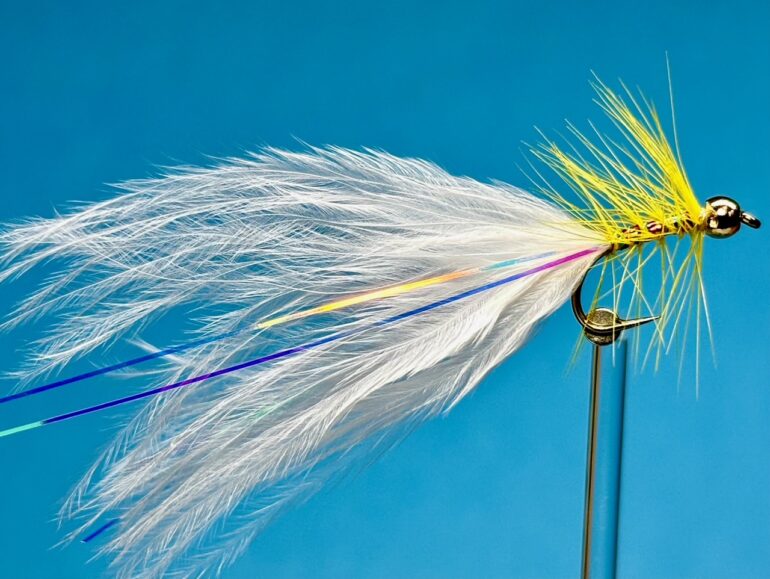
Fly of the Month Oct 2025 by Les Lockey
Fly of the Month – October
The Yellow Dancer
By Les Lockey
Hook: Kamasan B175, size 10, or similar.
Weight: 3.2mm gold brass bead.
Thread: Veevus GSP, 30D, in white.
Tail: “Springwater Blue” fl. white marabou, with 2 strands of pearl Flashabou either side.
Rib: Fine silver wire.
Body: Rainbow Flashabou.
Hackle: Yellow cock, palmered.
TYING
Photo 1. Feed the bead onto the hook small hole first, and then secure the hook in the vice. Start the thread behind the bead and wind on a bed of thread to a point opposite the hook point. Remove the thread tag and wind the thread back to behind the bead.
Photo 2. Take a bunch of marabou fibres from the plume and pull away the fluff from the cut basal ends to leave the bare fibre stems. With the prepared ends at the bead, tie in the bunch of marabou fibres on top of the shank and bind down to just before the hook bend forming a long tail.
Photo 3. Take 2 lengths of pearl Flashabou and tie them in so they sit centrally on the near side of the tail and very slightly longer than the marabou fibres. When secured, bring the pearl Flashabou to the opposite side of the tail and secure it in place with several more turns of thread. Trim off the excess pearl Flashabou.
Photo 4. Poke one end of the silver wire into the hole at the rear of the bead, then catch in the wire at the tail with a couple of turns of thread.
Photo 5. Tie in 4 or 5 strands of rainbow Flashabou ensuring the tag ends stop just behind the bead. Now bind down the wire plus all the tag ends of the Flashabou with thread, stopping at the bead.
Photo 6. Wind the Flashabou up the shank ensuring the flashabou strands spread out to produce a multi coloured striped body. Secure the Flashabou strands with thread immediately behind the bead and then remove the excess Flashabou.
Photo 7. Take a yellow cock hackle, remove the fluffy fibres from the base of the feather stem and trim the stem to about 2mm in length. Using well waxed thread, tie in the feather by the short bare stem, and wind on 2 turns of hackle immediately behind the bead and continue to palmer the hackle in open turns to the tail. Trap the hackle in place using the wire rib and continue to rib the wire through the hackle to the bead. Secure the rib with a few turns of waxed thread, worry off the wire rib and cut off the excess hackle near the tail.
Photo 8. Apply some varnish to the thread, whip finish through it and remove the thread to complete the fly.
Tying tips.
- This Scottish pattern dates back to the 1990s but it is basically a simple, tinsel bodied, wooly bugger type of lure. It is a straightforward fly to tie but try to keep the body slim and even. To this end, it helps to use a fine flat thread and ensure that all the tag ends of the various materials are trimmed the length of the body and all bound down to the bead with touching turns of thread.
- The original bead for this fly was coloured gold, but chartreuse and rainbow coloured beads are now often used as alternative options.
- I think the original thread colour for this fly was black, but I prefer to use white or yellow to blend in with the rest of the fly and make the finishing off point less obvious, however, chartreuse or fire orange thread can also be used if a hot spot is required behind the bead.
- To maximize movement in the pattern, keep the marabou tail long but quite sparce. I try to aim for 2 ½ to 3 times the length of the hook shank and I also like to use an oversized palmered body hackle for the same reason. Removing the fluff from the base of the marabou fibres reduces bulk and helps maintain a slim body profile.
- Before tying in the wire rib, I poke the end of the wire into the rear hole of the bead which helps keep the underbody free of lumps and bumps and avoids the possibility of snagging the thread on the end of the wire.
- For the body, I use 4 or 5 different coloured strands of rainbow flashabou, usually red, blue, green, gold and or silver, and wind them all up the shank as a single, flat, but broad tinsel to produce a multicoloured striped body. That said, many tiers simply use a single colour of tinsel with Mirage pearl, green, or holographic gold often being favoured.
- For a more robust body, wind the Flashabou body over a thin coat of superglue, but allow the glue to dry before continuing to finish the fly.
- For the hackle, I like to use a soft Chinese cock hackle to provide a bit more movement in the fly, but a palmered genetic hen hackle with a separate Indian cock hackle immediately behind the bead produces a very similar effect.
Fishing notes
- This is a hugely successful trout lure, capable of taking fish throughout the season, and as such, it can be found in just about every stillwater angler’s fly box.
- It can be fished on any density line from a floater to a very fast sinker, but on Coldingham Loch, floating or intermediate lines have to be the most productive options. In order to enhance the movement in the fly, it is best fished with a jerky, start and stop retrieve, but a steady figure of eight retrieve has also worked well for me in the past.
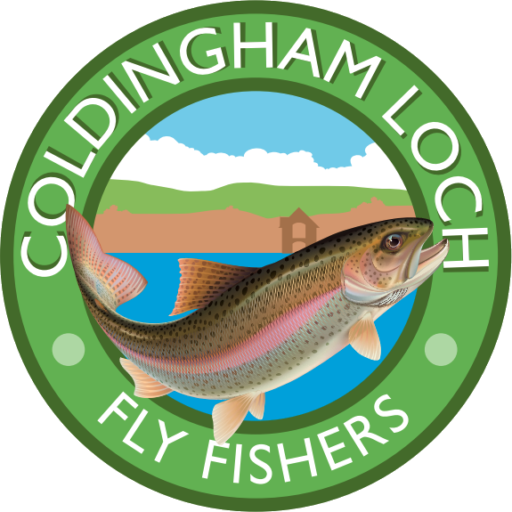

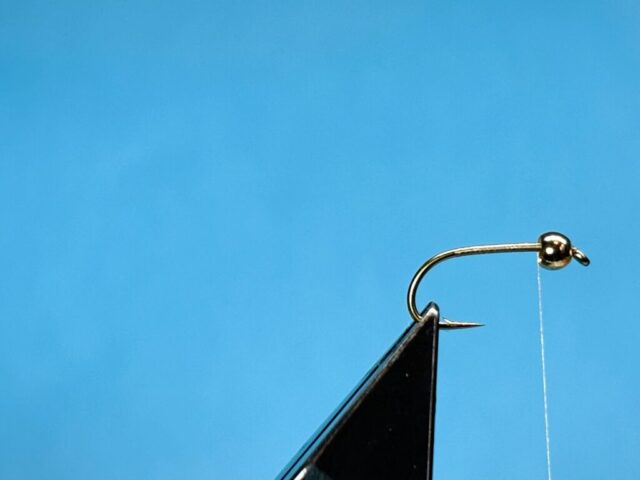
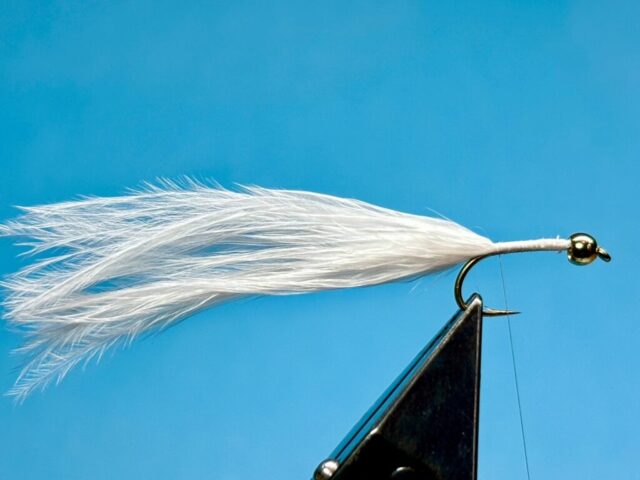
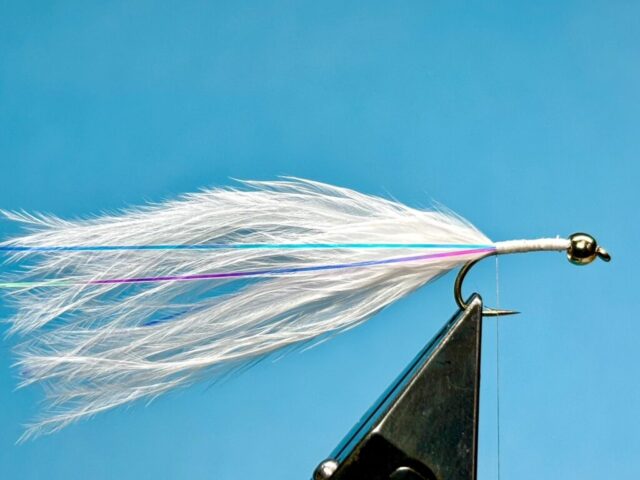
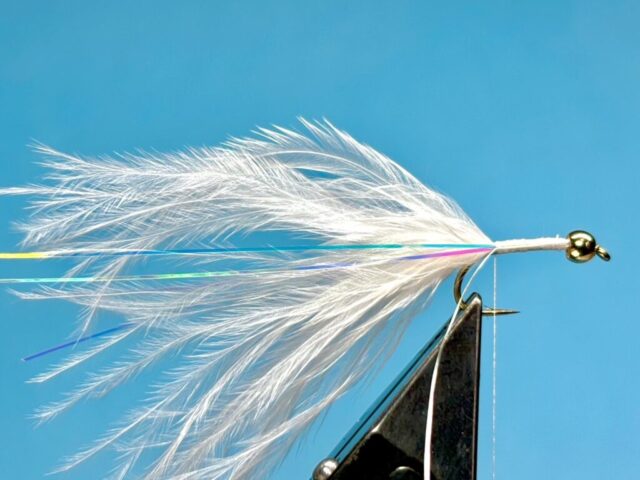
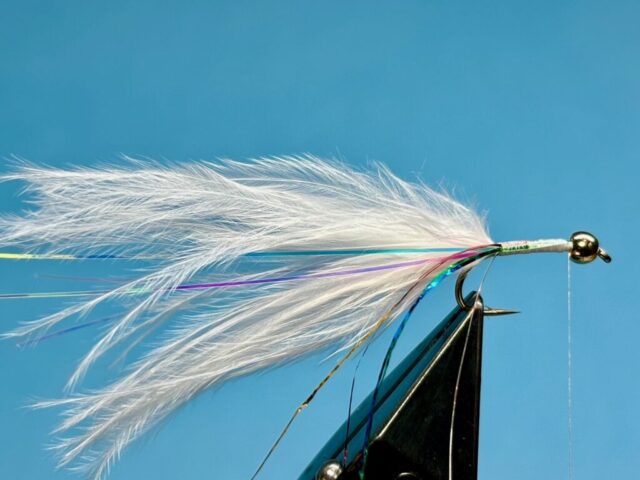
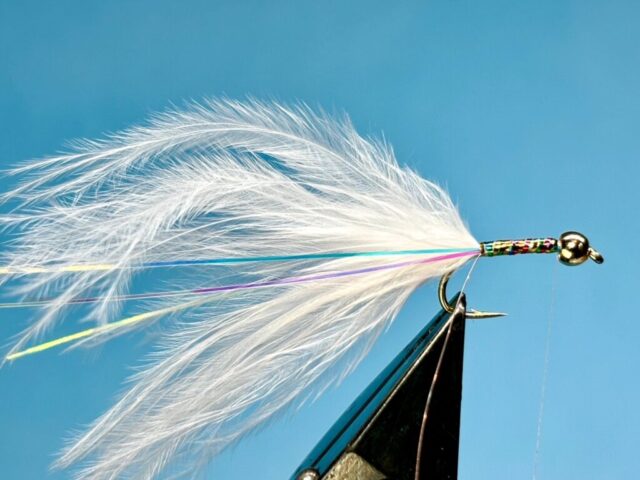
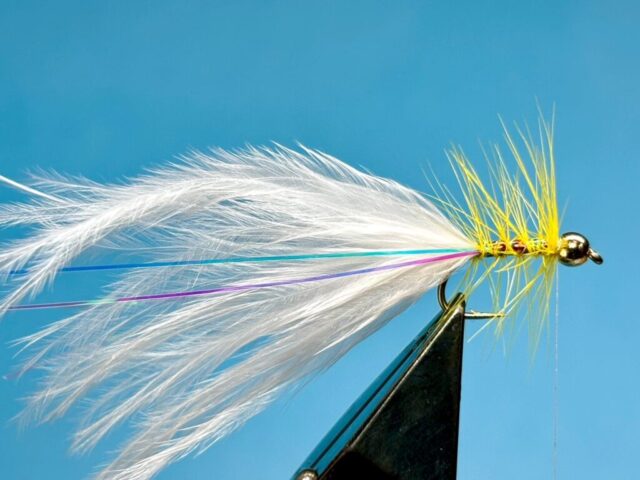
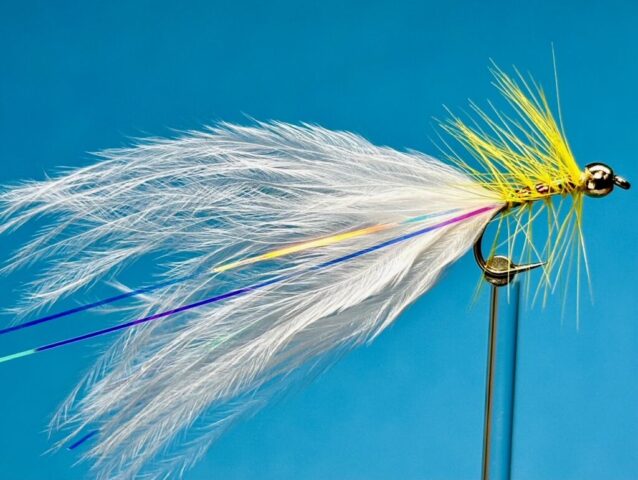

Recent Comments